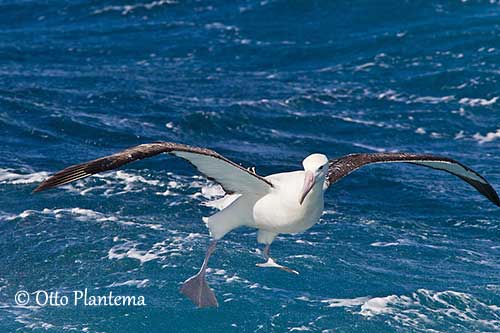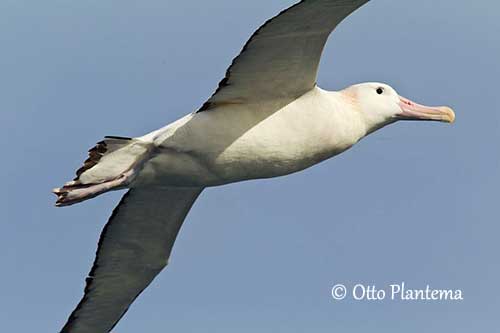
Fr: Albatros de Tristan
Ang: Tristan Albatross
All: Tristanalbatros
Esp: Albatros de Tristán de Acuña
Ita: Albatros urlatore atlantico
Nd: Tristanalbatros
Sd: tristanalbatross
Photographer:
Otto Plantema
Trips around the world
Text by Nicole Bouglouan
Sources:
HANDBOOK OF THE BIRDS OF THE WORLD vol 1 by Josep del Hoyo-Andrew Elliot-Jordi Sargatal - Lynx Edicions - ISBN: 8487334105
A Complete Guide to Antarctic Wildlife by Hadoram Shirihai and Illustrated by Brett Jarrett - Edited by Guy M. Kirwan - ALUL.A Press Oy, Finland - ISBN 9519894705
Agreement on the Conservation of Albatrosses and Petrels – ACAP
Demography and conservation of the Tristan albatross Diomedea [exulans] dabbenena
Avian Conservation & Ecology
Trends and tactics of mouse predation on Tristan Albatross Diomedea dabbenena chicks at Gough Island, South Atlantic Ocean
Department of Sustainability, Environment, Water, Population and Communities
Wikipedia, the free encyclopaedia
Tristan Albatross
Diomedea dabbenena
Procellariiformes Order – Diomedeidae Family
INTRODUCTION:
The Tristan Albatross was formerly a subspecies of the Wandering Albatross (D. exulans), but it is now a full species. It is more compact and smaller than D. exulans, with less white in plumage.
The Tristan Albatross is the third rarest albatross species. It has only two breeding areas in Tristan da Cunha archipelago, with a colony on Gough Island, and a few pairs on Inaccessible Island.
The decline of this species was caused by hunting by islanders in the 19th century, on the high plateau of Tristan da Cunha. Maybe this beautiful albatross will return to breed on its home island? It is now predator-free area, following the extermination of introduced rats and mice.
The Tristan Albatross is a Critically Endangered species.

DESCRIPTION OF THE BIRD:
Biometrics:
Length: 110 cm
Wingspan: 350 cm
Weight: M: 7300 g – F: 6800 g
The Tristan Albatross is a huge seabird very similar to D. exulans, but it has generally darker plumage.
The adult male is extensively white on head and body, but the upperwing is mainly black-brown, with white limited to central (elbow) and inner-coverts patches. The tail is white with blackish terminal band. On the underwing, both wing-tips and trailing edges are black.
On the white head, the ear-coverts are sometimes washed pink/orange, or all white.
The bill is pink with paler nail. The eyes are dark brown. Legs and webbed feet are pink or greyish.
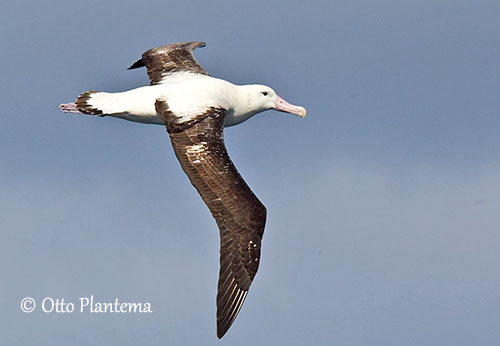
Male and female have similar plumage, but the male is larger overall.
Older males may show almost all-white upperwing-coverts.
The juvenile is dark with whitish face.
The younger immature has dark brown upperparts, with mantle, back and rump showing scaled pattern. Head and underparts are white.
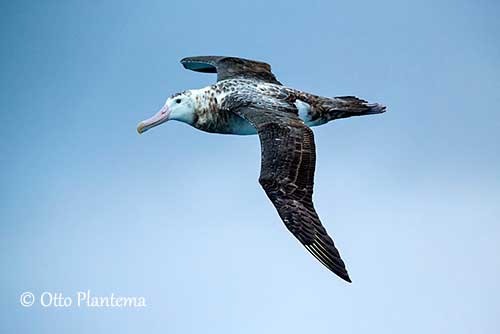
The older immature has greyish wash to the white feathers and is densely vermiculated. The crown is dark whereas nape and breast are spotted brown. The tail is largely dark.
The young female has mostly brown upperparts and upperwing, dusky-brown body sides, head and neck, and whitish face and belly patch.
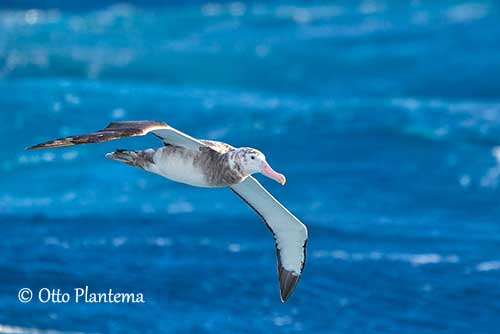
RANGE:
The Tristan Albatross is found in South Atlantic Ocean. It breeds on Gough Island, and sometimes on Inaccessible Island too, and formerly on Tristan da Cunha.
At sea, the range extends through S Atlantic Ocean to the W coast of South Africa, and to within 300 kilometres off the coasts of S Brazil. There are some records from SW Australia.
HABITAT:
The Tristan Albatross is marine and highly pelagic, feeding, resting and sleeping on ocean waters. During the nesting period, it occurs above the treeline and breeds on slopes with short, wet heath vegetation, between 400 and 700 metres of elevation. It usually avoids exposed peaks and denser vegetation at lower elevation.
CALLS AND SONGS: SOUNDS BY XENO-CANTO
The Tristan Albatross produces guttural and croaking noises and bill-clapping. These sounds are used during the courtship displays, but also at sea during disputes while competing for food around carcasses or fishing vessels.
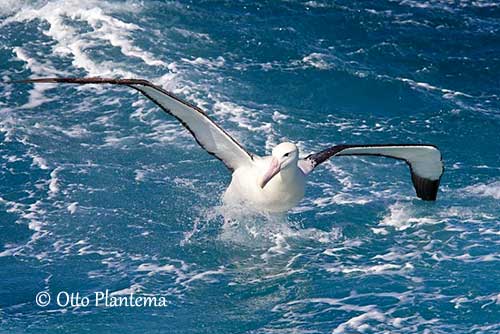
BEHAVIOUR IN THE WILD:
The Tristan Albatross’s diet is poorly known, because that is difficult to separate D. exulans from the present species at sea. But usually, the albatrosses of genus Diomedea feed on cephalopods, fish and crustaceans caught by surface-seizing.
They may form feeding flocks at rich food sources such as fishing vessels and carcasses.
From a study of the regurgitated food to the chick, it appears that the bioluminescent cephalopods are included in the diet of the Tristan Albatross, suggesting that this species often feeds at night.
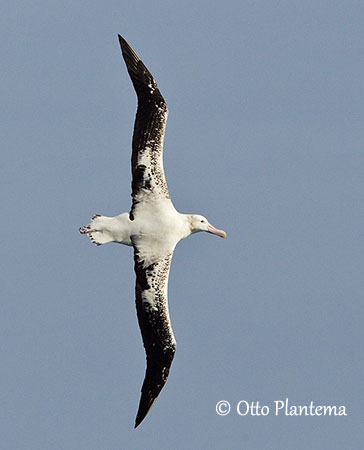
The Tristan Albatross is a colonial nester and its breeding cycle lasts 12 months. The entire breeding population is on Gough Island, whereas some pairs breed on Inaccessible Island, but there is an important decline and this colony is not considered viable.
Like most Diomedeidae, the Tristan Albatross is monogamous with long-term pair-bonds. The courtship displays include stereotyped postures, bill-circling, sky-pointing, flank-touching with the bill, usually accompanied by various calls and noises. Both mates display while facing each other.
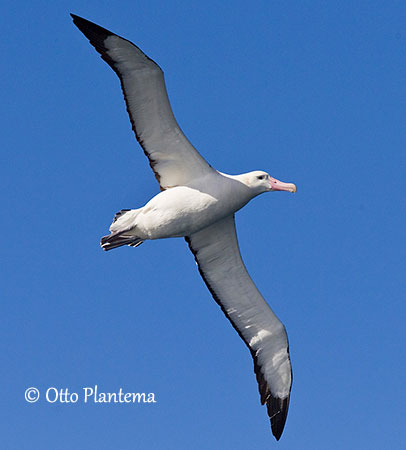
The Tristan Albatross is restricted to the S Atlantic Ocean during the breeding season, but then, they disperse to the E coasts of South America and SW coasts of Australia. They also move N off Namibia and Angola.
Like all albatrosses, it is an excellent flier, even in strong winds, but the large wingspan and the narrow wings are not suitable for powered flight. The take-off is a difficult manoeuvre and needs a short run over the surface before to become airborne. The landing is performed on slopes close to the nesting sites.
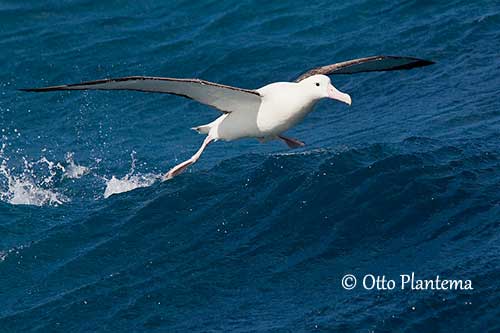
REPRODUCTION OF THIS SPECIES:
The Tristan Albatross is a biennally breeding species. The season starts in November/December with the birds returning to the colony. The egg-laying occurs in January/February, with the hatching in March/April.
Within the colony, the nests are about 3 metres apart, and sometimes up to 500 metres. The typical nest is a truncated cone made with grass and mud. It is placed on the ground in areas devoid of shrubby vegetation, usually above 300 metres, and generally between 400 and 700 metres of elevation.
The female lays a single whitish egg with some red spots in the central depression of the nest. Both adults share the incubation during 68 days. At hatching, the chick has white to pale greyish down and pinkish-white bill. It is fed by regurgitation by its parents. It fledges 8-9 months after hatching, often between November and January. The immature returns to the colony 3-7 years after fledging.
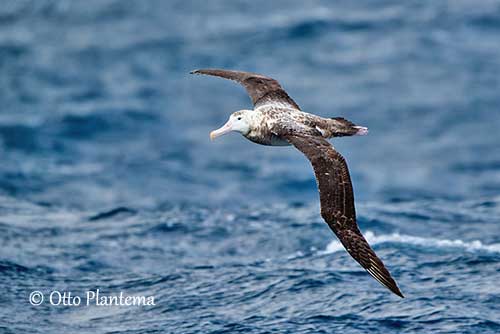
PROTECTION / THREATS / STATUS:
The Tristan Albatross is threatened at the colony on Gough Island by introduced house mice Mus musculus which attacks and kills the chicks, causing up to 50% of nest failures.
This seabird is vulnerable to capture on longlines, drowning in driftnets, and plastic ingestion (chicks). In addition, the low-lying islands where this species occurs are potentially susceptible to climate change through sea-level rise.
The annual breeding population is estimated at 1,698 pairs (2010), equating to 7,100 individuals (4,700 mature individuals).
This population is still declining and the Tristan Albatross is currently classified as Critically Endangered species.
